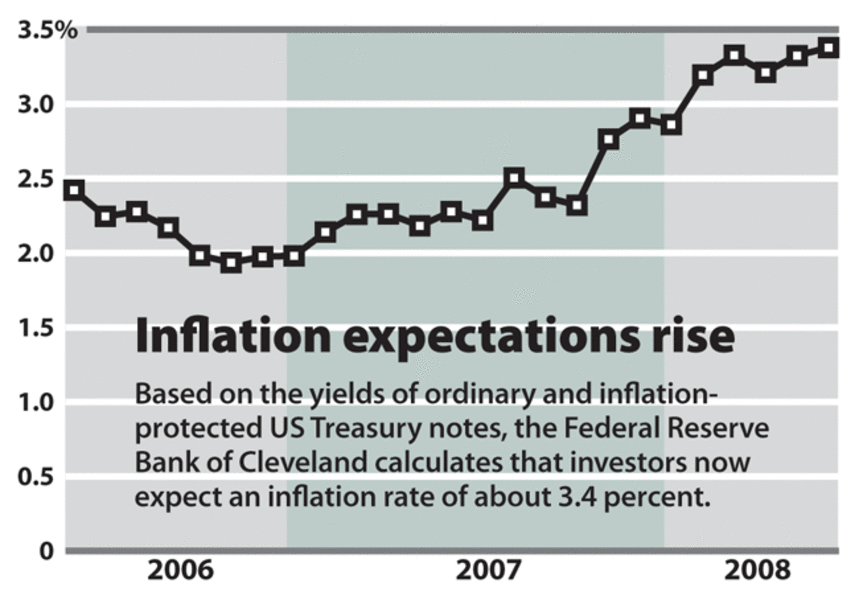Stagnation and inflation box in Fed
Loading...
The global threat called stagflation has grown in recent weeks and is putting the Federal Reserve in a box.
Ordinarily, America's central bank likes to set interest rates based on conditions at home.
But conditions "at home" – including the Fed's own monetary policy – are increasingly tied to global trends.
Economists say that's one reason why Fed Chairman Ben Bernanke this week voiced concern about inflation, and why financial markets are now factoring in the likelihood of a higher Federal Reserve interest rate by the end of the year.
It's not that the troubles within the US economy have gone away. The slowdown that has caused the Fed to cut interest rates in recent months could still turn into a recession. That stagnation puts the "stag" in "stagflation."
But the global inflation pressures – centered in commodity prices expected to drive the US inflation rate higher in a report Friday morning – haven't been cooling along with the US economy.
At a minimum, many economists say, this means the Fed has little leeway to cut its short-term interest further from its current level of 2 percent. And the Fed could even be forced into an unusual position of raising interest rates later this year, even while unemployment at home is rising.
"The important thing to recognize is that we are more interconnected financially with the rest of the world," says Tim Duy, an economist at the University of Oregon in Eugene. "The expectation ... was that oil prices were going to go down" as the US economy slowed, but that didn't happen, he says.
One reason is simply that the US, while still by far the world's largest single economy, is now counterbalanced somewhat by fast-rising emerging nations. Their continued strength has buoyed both the global economy and commodity prices.
But Mr. Duy says that another factor may be at work – an unintended consequence of the Fed's recent interest-rate cuts.
When the Fed eases monetary policy to stimulate growth at home, other nations with currencies pegged to the dollar also have to ease their monetary conditions in order to maintain their exchange rates. The result is more money in the global system, which translates into more upward pressure on oil, food, and other prices.
"That linkage of domestic policy having global impact [and then rippling back into US consumer prices] is new for the Federal Reserve," Duy says. "If it is true, I think it does represent a significant change."
It's the magnitude of such linkages that may be new. The Fed has long been aware, for example, that a weakening dollar pushes up the cost of goods imported to the US, thus boosting US inflation a bit.
But it seems that global conditions may now be a stronger constraint on Fed policy than in other recent economic cycles.
In a speech Monday, Mr. Bernanke hinted at the stagflation scenario without using that word directly. He talked about "downside" risks to economic growth, but also of "upside risks to inflation."
Fed Vice Chairman Donald Kohn hit a similar note in a speech on Wednesday.
He said that after an upward spike in oil prices, "appropriate monetary policy" might need to allow for a rise in both inflation and unemployment as a result.
A rise in the price of oil, in itself, is not inflation. Prices of all goods are always shifting for reasons of supply and demand. What policymakers worry about is the general trend of prices and also the role that public expectations can play in making inflation hard to contain.
"The [Fed] will strongly resist an erosion of longer-term inflation expectations, as an unanchoring of those expectations would be destabilizing for growth as well as for inflation," Bernanke said in his speech.
By some measures, the public has begun to expect more inflation in recent months (see chart). And as of this week, futures markets are predicting that the Fed will raise short-term interest rates by about half a percentage point before the end of the year.
"The Fed knows it's in a very tight spot," says Asha Bangalore, an economist at the Northern Trust Co. in Chicago. "You have a confluence of forces: Higher import prices, higher oil prices, a weak economy, and weak dollar. This is not a very easy combination."
In the end, she says, these challenges may require greater cooperation among the world's central banks.
"It's a shared responsibility, and they have to figure out how to manage this," Ms. Bangalore says.
For many governments, the priority is shifting toward curbing inflation – given signs that commodity prices are causing consumer unrest. Spanish truck drivers, for example, blocked highways in protest this week.
Jean-Claude Trichet, head of European Central Bank, has hinted at a possible interest-rate increase in July.
For now, the Fed may be hoping that tough talk can keep financial markets steady. But if the Fed resists raising interest rates while other nations are doing so, it could weaken the dollar further.





